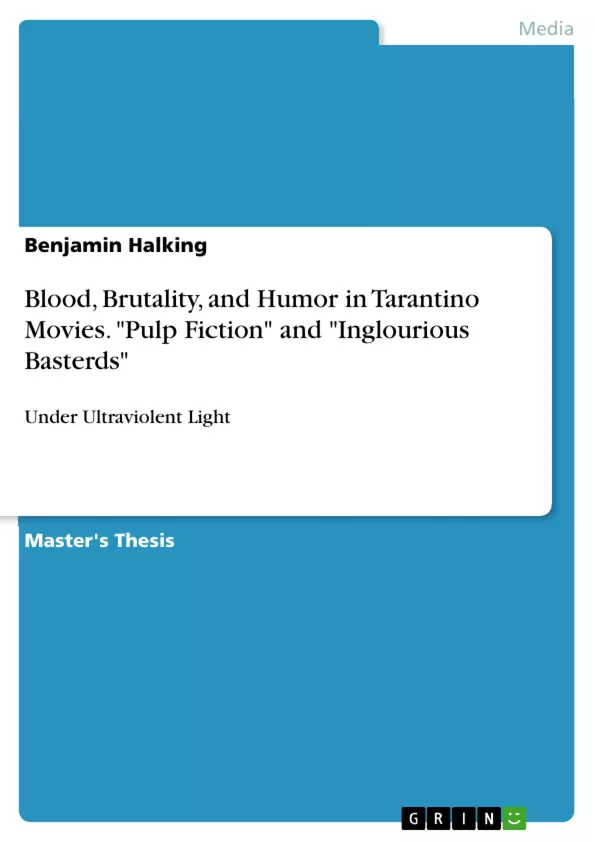This thesis gives an analysis of technical as well as contextual items that Tarantino uses time and again in order to produce violent movies and give them his very personal touch. Doing that, he makes use of two basic elements: humor and an abundant amount of violence. It would sound like humor and violence do not go well together. The author argues that Tarantino accomplishes this feat with a seeming effortlessness which could just as well be an elaborate plan to criticize the use of violence and advocate a life free of crime.
In order to do that, two scenes from different stages of Tarantino’s career were chosen, both personally and cinematically. The first scene that is analyzed is taken from his 1994 independent movie "Pulp Fiction". The second scene analyzed is from "Inglourious Basterds" from 2009.
The two films in focus are different in various aspects such as the scenery and setting, the cultural and historical context or sociocultural circumstances at the time of their release, to name a few. This is why they make an excellent contrast to show the differences but also the similarities in Tarantino’s work to deduct a development from the comparison.
The first focus of the thesis lies on the concept of violence. It gives a brief history both diachronically as well as synchronically. After that, the concept of humor is addressed, and with that why something is perceived as being funny (or maybe not). The idea of alienation between what the viewer or listener expects and what they are actually provided with plays an important role here.
A conclusion to this thesis deals with why Tarantino chooses the depiction of (graphic) violence that he is known and famous for. Tarantino changes his modus operandi over the years when it comes to the representation of brutality in his movies. But he stays true to himself in the very core of the kind of violence he implicates in his films, using the techniques and stylistic devices he is known and loved for.
Quentin Tarantino is often synonymous with making ultraviolent movies. Just as often, he is celebrated for his distinctive way of making movies which made him one of the most famous filmmakers in Hollywood. The fact that he has been in the business for almost 30 years proves that he does many things right even when critique of his representation of brutality arises with almost each of his films.
Table of Contents
- Chapter 1 – Introduction
- Chapter 2 – The Concept of Violence
- Chapter 3 – The Concept of Humor
- Chapter 4 – Analysis in Context
- Chapter 4.1 – Pulp Fiction
- Chapter 4.2 – Inglourious Basterds
Objectives and Key Themes
This thesis will analyze the technical and contextual elements that Quentin Tarantino uses to create violent movies with a distinct, personal touch. The focus will be on two main elements: humor and an abundant amount of violence. The thesis will argue that Tarantino accomplishes this feat seemingly effortlessly, potentially intending to criticize the use of violence and advocate for a life free of crime.
- The concept of violence in film and its historical development
- The concept of humor in film and the idea of incongruence
- The interplay of violence and humor in Tarantino’s films
- The use of excess in Tarantino's depiction of violence
- The moral implications of Tarantino's work
Chapter Summaries
Chapter 1 provides an introduction to the topic, discussing Tarantino’s cinematic style and the role of violence and humor in his work. Chapter 2 examines the concept of violence in film, tracing its historical evolution and analyzing its various forms and representations.
Chapter 3 explores the concept of humor in film, emphasizing the concept of incongruence and its role in creating comedic effects. Chapter 4 delves into the specific analysis of two scenes, one from Pulp Fiction and the other from Inglourious Basterds, examining the interplay of violence and humor, the use of excess, and the moral implications of these scenes.
Keywords
This thesis focuses on the following key topics: cinematic violence, humor, incongruence, excessive violence, Quentin Tarantino, Pulp Fiction, Inglourious Basterds, American film, moral implications, stylistic devices.
- Citar trabajo
- Benjamin Halking (Autor), 2019, Blood, Brutality, and Humor in Tarantino Movies. "Pulp Fiction" and "Inglourious Basterds", Múnich, GRIN Verlag, https://www.grin.com/document/1289289



